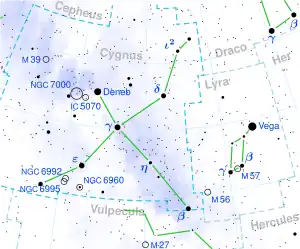NML Cygni
NML Cygni or V1489 Cygni is a red hypergiant star.[1] It is one of the largest stars known at present. It is about 1,640 times the Sun's radius, However an older study from 2010 says it is 1,183 solar radii.[2] It is one of the extremely luminous supergiant stars.[3] It was discovered in 1965, by Gerry Neugebauer, D.M. Martz and Robert Leighton.[4] The name 'NML' comes from the names of the three discoverers.[5]
.png.webp)

NML Cygni's distance from Earth is about 5,250 light-years.[3] This star has dust surrounding it. It has a bean-shaped asymmetric nebula with H2O vapour.[6] It is a semiregular variable star with a period of about 940 days.[7]
This star is a part of the Cygnus OB2 association, which is 1.74 ± 0.2 kpc away. This is one of the nearest massive star groups to the Sun.[7] This group includes some of the most massive and most luminous stars known, including the suspected luminous blue variable Cyg OB2 #12. NML Cyg is a massive oxygen-rich star.[8] Molecules like H2O, SiO, CO, HCN, CS, SO, SO2 and H2S are also present.[4]
NML Cygni has two dense envelopes of dust and molecules. The star has one of the largest mass loss rates at around 2 × 10-4 M☉ per year.[4] These dust envelopes are formed by the high mass emission rate.[7]
References
- Zhang, B.; Reid, M. J.; Menten, K. M.; Zheng, X. W.; Brunthaler, A. (2012). "The distance and size of the red hypergiant NML Cygni from VLBA and VLA astrometry". Astronomy & Astrophysics. 544 (A42): A42. arXiv:1207.1850. Bibcode:2012A&A...544A..42Z. doi:10.1051/0004-6361/201219587. S2CID 55509287.
- De Beck, E.; Decin, L.; De Koter, A.; Justtanont, K.; Verhoelst, T.; Kemper, F.; Menten, K. M. (2010). "Probing the mass-loss history of AGB and red supergiant stars from CO rotational line profiles". Astronomy & Astrophysics. 523: A18. arXiv:1008.1083. doi:10.1051/0004-6361/200913771. S2CID 16131273.
- Schuster M.T. (2007). Investigating the circumstellar environments of the cool hypergiants. p. 57. ISBN 978-0-549-32782-0.
- Marvel, Kevin (1996). "NML Cygni". The circumstellar environment of evolved stars as revealed by studies of circumstellar water masers. Universal-Publishers. pp. 182–212. ISBN 978-1-58112-061-5. Retrieved 23 August 2012.
- Hearnshaw J.B. (1996). "New infrared sources and their interpretation". The measurement of starlight: two centuries of astronomical photometry. Cambridge University Press. p. 278. ISBN 978-0-521-40393-1. Retrieved 23 August 2012.
- Schuster M.T; Humphreys R.M. & Marengo M. 2006. The circumstellar environments of NML Cygni and the cool hypergiants. The Astronomical Journal 131, 603.
- Schuster M.T. et al 2009. Imaging the cool hypergiant NML Cygni's dusty circumstellar envelope with adaptive optics. Astrophysical Journal 699 (2): 1423.
- "Combined array for research in millimeter-wave astronomy" (PDF). Retrieved August 27, 2012.